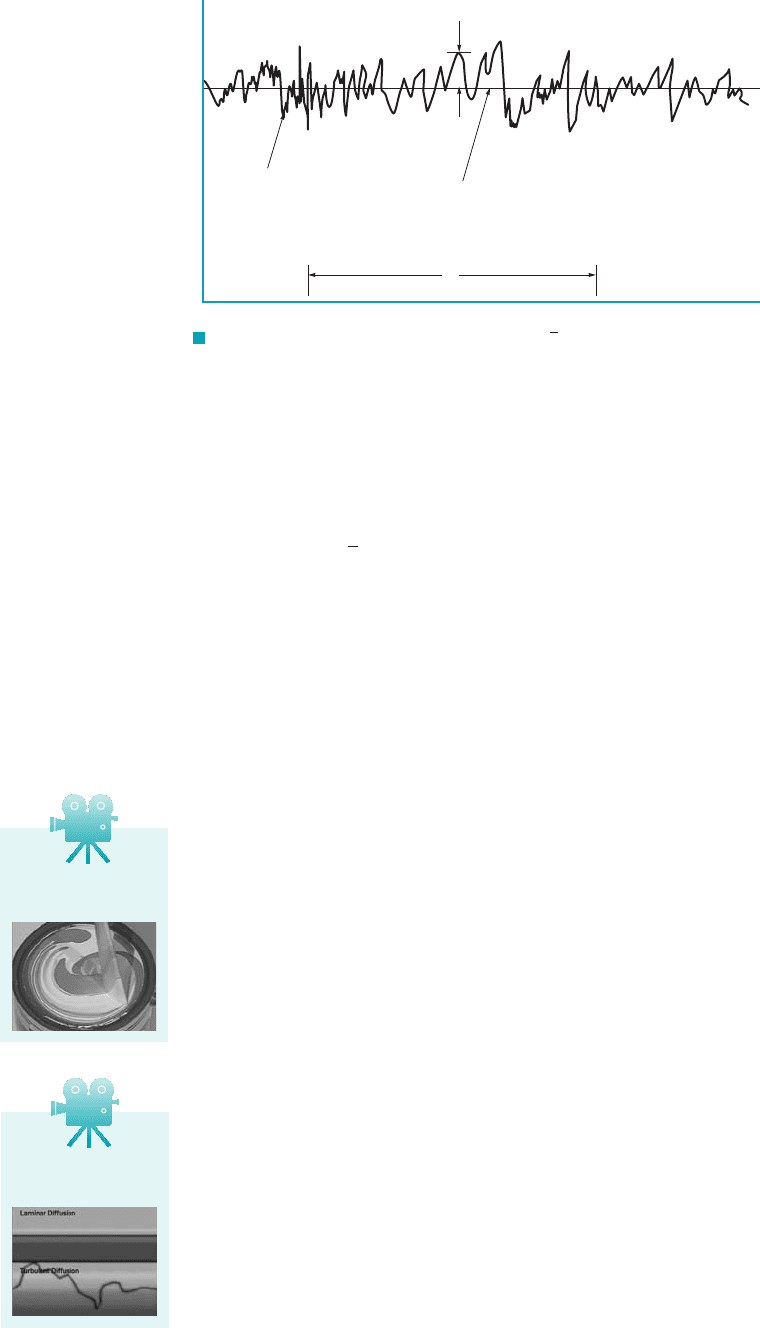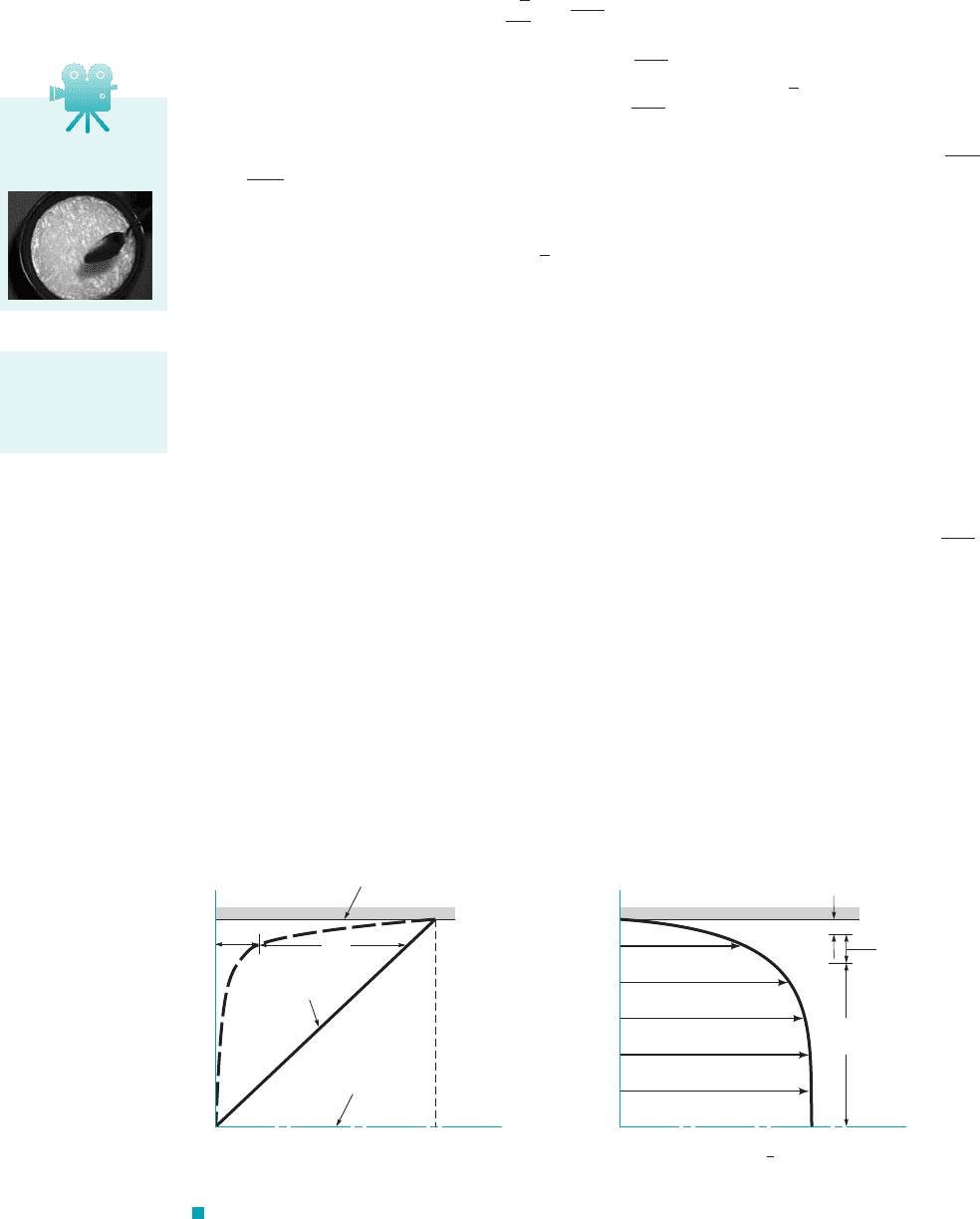Munson B.R. Fundamentals of Fluid Mechanics
Подождите немного. Документ загружается.


factor, which is defined to be In this text we will use only the Darcy friction factor.2Thus,
the friction factor for laminar fully developed pipe flow is simply
(8.19)
as shown by the figure in the margin.
By substituting the pressure drop in terms of the wall shear stress 1Eq. 8.52, we obtain an al-
ternate expression for the friction factor as a dimensionless wall shear stress
(8.20)
Knowledge of the friction factor will allow us to obtain a variety of information regarding pipe
flow. For turbulent flow the dependence of the friction factor on the Reynolds number is much
more complex than that given by Eq. 8.19 for laminar flow. This is discussed in detail in
Section 8.4.
8.2.4 Energy Considerations
In the previous three sections we derived the basic laminar flow results from application of
or dimensional analysis considerations. It is equally important to understand the implications of
energy considerations of such flows. To this end we consider the energy equation for incompress-
ible, steady flow between two locations as is given in Eq. 5.89
(8.21)
Recall that the kinetic energy coefficients, and compensate for the fact that the velocity
profile across the pipe is not uniform. For uniform velocity profiles, whereas for any
nonuniform profile, The head loss term, accounts for any energy loss associated with
the flow. This loss is a direct consequence of the viscous dissipation that occurs throughout the
fluid in the pipe. For the ideal 1inviscid2cases discussed in previous chapters,
and the energy equation reduces to the familiar Bernoulli equation discussed in Chapter 3
1Eq. 3.72.
Even though the velocity profile in viscous pipe flow is not uniform, for fully developed
flow it does not change from section 112to section 122so that Thus, the kinetic energy
is the same at any section and the energy equation becomes
(8.22)
The energy dissipated by the viscous forces within the fluid is supplied by the excess work done
by the pressure and gravity forces as shown by the figure in the margin.
A comparison of Eqs. 8.22 and 8.10 shows that the head loss is given by
1recall and which, by use of Eq. 8.4, can be rewritten in the form
(8.23)
It is the shear stress at the wall 1which is directly related to the viscosity and the shear stress
throughout the fluid2that is responsible for the head loss. A closer consideration of the assump-
tions involved in the derivation of Eq. 8.23 will show that it is valid for both laminar and turbu-
lent flow.
h
L
4/t
w
gD
z
2
z
1
/ sin u2,p
1
p
2
¢p
h
L
2t/
gr
a
p
1
g
z
1
b a
p
2
g
z
2
b h
L
1a
1
V
1
2
2 a
2
V
2
2
22
a
1
a
2
.
a
1
a
2
1, h
L
0,
h
L
,a 7 1.
a 1,
a
2
,a
1
p
1
g
a
1
V
1
2
2g
z
1
p
2
g
a
2
V
2
2
2g
z
2
h
L
F ma
f
8t
w
rV
2
f
64
Re
f
4.
8.2 Fully Developed Laminar Flow 397
10
1
0.1
0.01
10 100
Laminar flow
1000
f
Re
z
2
h
L
z
1
(1)
(2)
p
2
p
1
The head loss in a
pipe is a result of
the viscous shear
stress on the wall.
JWCL068_ch08_383-460.qxd 9/23/08 10:51 AM Page 397

398 Chapter 8 ■ Viscous Flow in Pipes
GIVEN The flowrate, Q, of corn syrup through the horizontal
pipe shown in Fig. E8.3ais to be monitored by measuring the pres-
sure difference between sections 112and 122. It is proposed that
where the calibration constant, K, is a function of tem-
perature, T, because of the variation of the syrup’s viscosity and
density with temperature. These variations are given in Table E8.3.
FIND (a) Plot versus T for (b) De-
termine the wall shear stress and the pressure drop,
for and (c)For the con-
ditions of part 1b2, determine the net pressure force,
and the net shear force, on the fluid within the pipe be-
tween the sections 112and 122.
pD/t
w
,
1pD
2
42 ¢p,
T 100 °F.
Q 0.5 ft
3
s
¢p p
1
p
2
,
60 °F T 160 °F.K1T2
Q K ¢p,
S
OLUTION
Laminar Pipe Flow Properties
Hence, the flow is laminar. From Eq. 8.5 the wall shear stress
is
(Ans)
(c) For the conditions of part 1b2, the net pressure force, on
the fluid within the pipe between sections 112and 122is
(Ans)
Similarly, the net viscous force, on that portion of the fluid is
(Ans)
COMMENT Note that the values of these two forces are the
same. The net force is zero; there is no acceleration.
2p c
3
21122
ft d16 ft211.24 lb
ft
2
2 5.84 lb
F
v
2p a
D
2
b /t
w
F
v
,
F
p
p
4
D
2
¢p
p
4
a
3
12
ftb
2
1119 lb
ft
2
2 5.84 lb
F
p
,
t
w
¢pD
4/
1119 lb
ft
2
21
3
12
ft2
416 ft2
1.24 lb
ft
2
E
XAMPLE 8.3
(a) If the flow is laminar it follows from Eq. 8.9 that
or
(1)
where the units on and are and re-
spectively. Thus
(Ans)
where the units of K are By using values of the viscosity
from Table E8.3, the calibration curve shown in Fig. E8.3b is ob-
tained. This result is valid only if the flow is laminar.
COMMENT As shown in Section 8.5, for turbulent flow the
flowrate is not linearly related to the pressure drop so it would not
be possible to have Note also that the value of K is in-
dependent of the syrup density 1 was not used in the calculations2
since laminar pipe flow is governed by pressure and viscous ef-
fects; inertia is not important.
(b) For the viscosity is
so that with a flowrate of the pressure drop 1accord-
ing to Eq. 8.92is
(Ans)
provided the flow is laminar. For this case
so that
1380 6 2100
Re
rVD
m
12.05 slugs
ft
3
2110.2 ft
s21
3
12
ft2
13.8 10
3
lb
#
s
ft
2
2
V
Q
A
0.5 ft
3
s
p
4
1
3
12
ft2
2
10.2 ft
s
119 lb
ft
2
12813.8 10
3
lb
#
s
ft
2
216 ft210.5 ft
3
s2
p1
3
12
ft2
4
¢p
128m/Q
pD
4
Q 0.5 ft
3
s
10
3
lb
#
s
ft
2
m 3.8 T 100 °F,
r
Q K ¢p.
ft
5
lb
#
s.
K
1.60 10
5
m
lb
#
s
ft
2
,ft
3
s, lb
ft
2
,
mQ, ¢p,
Q K ¢p
1.60 10
5
m
¢p
Q
pD
4
¢p
128m/
p1
3
12
ft2
4
¢p
128m16 ft2
F I G U R E E8.3
TABLE E8.3
T ( ) (slugs兾 )()
60 2.07
80 2.06
100 2.05
120 2.04
140 2.03
160 2.02 2.3 10
5
9.2 10
5
4.4 10
4
3.8 10
3
1.9 10
2
4.0 10
2
lb ⴢ s
ft
2
Mft
3
RⴗF
3-in.
diameter
6 ft
(1)
(
a)
(2)
Q
(b)
10
0
10
–1
10
–2
10
–3
10
–4
60 100 140
T, °F
180
K, ft
5
/(lb
•
s)
JWCL068_ch08_383-460.qxd 9/23/08 10:51 AM Page 398

8.3 Fully Developed Turbulent Flow 399
In the previous section various properties of fully developed laminar pipe flow were discussed.
Since turbulent pipe flow is actually more likely to occur than laminar flow in practical situations,
it is necessary to obtain similar information for turbulent pipe flow. However, turbulent flow is a
very complex process. Numerous persons have devoted considerable effort in attempting to under-
stand the variety of baffling aspects of turbulence. Although a considerable amount of knowledge
about the topic has been developed, the field of turbulent flow still remains the least understood
area of fluid mechanics. In this book we can provide only some of the very basic ideas concern-
ing turbulence. The interested reader should consult some of the many books available for further
reading 1Refs. 1–32.
8.3.1 Transition from Laminar to Turbulent Flow
Flows are classified as laminar or turbulent. For any flow geometry, there is one 1or more2di-
mensionless parameter such that with this parameter value below a particular value the flow is
laminar, whereas with the parameter value larger than a certain value the flow is turbulent. The
important parameters involved 1i.e., Reynolds number, Mach number2and their critical values de-
pend on the specific flow situation involved. For example, flow in a pipe and flow along a flat
plate 1boundary layer flow, as is discussed in Section 9.2.42can be laminar or turbulent, depend-
ing on the value of the Reynolds number involved. As a general rule for pipe flow, the value of
the Reynolds number must be less than approximately 2100 for laminar flow and greater than ap-
proximately 4000 for turbulent flow. For flow along a flat plate the transition between laminar
and turbulent flow occurs at a Reynolds number of approximately 500,000 1see Section 9.2.42,
where the length term in the Reynolds number is the distance measured from the leading edge of
the plate.
Consider a long section of pipe that is initially filled with a fluid at rest. As the valve is
opened to start the flow, the flow velocity and, hence, the Reynolds number increase from zero 1no
flow2to their maximum steady-state flow values, as is shown in Fig. 8.11. Assume this transient
process is slow enough so that unsteady effects are negligible 1quasi-steady flow2. For an initial
time period the Reynolds number is small enough for laminar flow to occur. At some time the
Reynolds number reaches 2100, and the flow begins its transition to turbulent conditions. Intermit-
tent spots or bursts of turbulence appear. As the Reynolds number is increased, the entire flow field
becomes turbulent. The flow remains turbulent as long as the Reynolds number exceeds approxi-
mately 4000.
A typical trace of the axial component of velocity measured at a given location in the flow,
is shown in Fig. 8.12. Its irregular, random nature is the distinguishing feature of turbu-
lent flow. The character of many of the important properties of the flow 1pressure drop, heat trans-
fer, etc.2depends strongly on the existence and nature of the turbulent fluctuations or randomness
u ⫽ u1t2,
8.3 Fully Developed Turbulent Flow
3
2
1
0 0
2000
4000
Re = VD/v
t, sec
u, ft/s
Turbulent
bursts
Random,
turbulent fluctuations
Turbulent
Transitional
Laminar
F I G U R E 8.11 Transition from laminar to turbulent flow in a pipe.
Turbulent flows
involve randomly
fluctuating param-
eters.
JWCL068_ch08_383-460.qxd 9/23/08 10:51 AM Page 399

indicated. In previous considerations involving inviscid flow, the Reynolds number is 1strictly speak-
ing2infinite 1because the viscosity is zero2, and the flow most surely would be turbulent. However,
reasonable results were obtained by using the inviscid Bernoulli equation as the governing equa-
tion. The reason that such simplified inviscid analyses gave reasonable results is that viscous
effects were not very important and the velocity used in the calculations was actually the time-
averaged velocity, indicated in Fig. 8.12. Calculation of the heat transfer, pressure drop, and
many other parameters would not be possible without inclusion of the seemingly small, but very
important, effects associated with the randomness of the flow.
Consider flow in a pan of water placed on a stove. With the stove turned off, the fluid is
stationary. The initial sloshing has died out because of viscous dissipation within the water.
With the stove turned on, a temperature gradient in the vertical direction, is produced.
The water temperature is greatest near the pan bottom and decreases toward the top of the fluid
layer. If the temperature difference is very small, the water will remain stationary, even though
the water density is smallest near the bottom of the pan because of the decrease in density with
an increase in temperature. A further increase in the temperature gradient will cause a buoy-
ancy-driven instability that results in fluid motion—the light, warm water rises to the top, and
the heavy, cold water sinks to the bottom. This slow, regular “turning over” increases the heat
transfer from the pan to the water and promotes mixing within the pan. As the temperature gra-
dient increases still further, the fluid motion becomes more vigorous and eventually turns into
a chaotic, random, turbulent flow with considerable mixing, vaporization (boiling) and greatly
increased heat transfer rate. The flow has progressed from a stationary fluid, to laminar flow,
and finally to turbulent, multi-phase (liquid and vapor) flow.
Mixing processes and heat and mass transfer processes are considerably enhanced in turbu-
lent flow compared to laminar flow. This is due to the macroscopic scale of the randomness in tur-
bulent flow. We are all familiar with the “rolling,” vigorous eddy type motion of the water in a pan
being heated on the stove 1even if it is not heated to boiling2. Such finite-sized random mixing is
very effective in transporting energy and mass throughout the flow field, thereby increasing the var-
ious rate processes involved. Laminar flow, on the other hand, can be thought of as very small but
finite-sized fluid particles flowing smoothly in layers, one over another. The only randomness and
mixing take place on the molecular scale and result in relatively small heat, mass, and momentum
transfer rates.
Without turbulence it would be virtually impossible to carry out life as we now know it.
Mixing is one positive application of turbulence, as discussed above, but there are other situations
where turbulent flow is desirable. To transfer the required heat between a solid and an adjacent
fluid 1such as in the cooling coils of an air conditioner or a boiler of a power plant2would require
an enormously large heat exchanger if the flow were laminar. Similarly, the required mass trans-
fer of a liquid state to a vapor state 1such as is needed in the evaporated cooling system associ-
ated with sweating2would require very large surfaces if the fluid flowing past the surface were
0T
Ⲑ
0z,
u,
400 Chapter 8 ■ Viscous Flow in Pipes
V8.4 Stirring color
into paint
V8.5 Laminar and
turbulent mixing
u(t)
_
u = time-averaged
(or mean) value
u'
T
t
O
t
O
+ T
u
t
F I G U R E 8.12 The time-averaged, and fluctuating, descrip-
tion of a parameter for turbulent flow.
u,u
,
JWCL068_ch08_383-460.qxd 9/23/08 10:51 AM Page 400

laminar rather than turbulent. As shown in Chapter 9, turbulence can also aid in delaying flow
separation.
8.3 Fully Developed Turbulent Flow 401
Fluids in the News
Smaller heat exchangers Automobile radiators, air condition-
ers, and refrigerators contain heat exchangers that transfer en-
ergy from (to) the hot (cold) fluid within the heat exchanger
tubes to (from) the colder (hotter) surrounding fluid. These
units can be made smaller and more efficient by increasing the
heat transfer rate across the tubes’ surfaces. If the flow through
the tubes is laminar, the heat transfer rate is relatively small.
Significantly larger heat transfer rates are obtained if the flow
within the tubes is turbulent. Even greater heat transfer rates
can be obtained by the use of turbulence promoters, sometimes
termed “turbulators,” which provide additional turbulent mix-
ing motion than would normally occur. Such enhancement
mechanisms include internal fins, spiral wire or ribbon inserts,
and ribs or grooves on the inner surface of the tube. While these
mechanisms can increase the heat transfer rate by 1.5 to 3 times
over that for a bare tube at the same flowrate, they also increase
the pressure drop (and therefore the power) needed to produce
the flow within the tube. Thus, a compromise involving in-
creased heat transfer rate and increased power consumption is
often needed.
Turbulence is also of importance in the mixing of fluids. Smoke from a stack would con-
tinue for miles as a ribbon of pollutant without rapid dispersion within the surrounding air if the
flow were laminar rather than turbulent. Under certain atmospheric conditions this is observed to
occur. Although there is mixing on a molecular scale 1laminar flow2, it is several orders of magni-
tude slower and less effective than the mixing on a macroscopic scale 1turbulent flow2. It is consid-
erably easier to mix cream into a cup of coffee 1turbulent flow2than to thoroughly mix two colors
of a viscous paint 1laminar flow2.
In other situations laminar 1rather than turbulent2flow is desirable. The pressure drop in pipes
1hence, the power requirements for pumping2can be considerably lower if the flow is laminar rather
than turbulent. Fortunately, the blood flow through a person’s arteries is normally laminar, except
in the largest arteries with high blood flowrates. The aerodynamic drag on an airplane wing can
be considerably smaller with laminar flow past it than with turbulent flow.
8.3.2 Turbulent Shear Stress
The fundamental difference between laminar and turbulent flow lies in the chaotic, random behav-
ior of the various fluid parameters. Such variations occur in the three components of velocity, the
pressure, the shear stress, the temperature, and any other variable that has a field description. Tur-
bulent flow is characterized by random, three-dimensional vorticity 1i.e., fluid particle rotation or
spin; see Section 6.1.32. As is indicated in Fig. 8.12, such flows can be described in terms of their
mean values 1denoted with an overbar2on which are superimposed the fluctuations 1denoted with
a prime2. Thus, if is the x component of instantaneous velocity, then its time mean
1or time-average2value, is
(8.24)
where the time interval, T, is considerably longer than the period of the longest fluctuations, but con-
siderably shorter than any unsteadiness of the average velocity. This is illustrated in Fig. 8.12.
The fluctuating part of the velocity, , is that time-varying portion that differs from the av-
erage value
(8.25)
Clearly, the time average of the fluctuations is zero, since
⫽
1
T
1T u
⫺ T u2⫽ 0
u
¿
⫽
1
T
冮
t
0
⫹T
t
0
1u ⫺ u 2 dt ⫽
1
T
a
冮
t
0
⫹T
t
0
u dt ⫺ u
冮
t
0
⫹T
t
0
dtb
u ⫽ u ⫹ u¿ or u¿ ⫽ u ⫺ u
u¿
u
⫽
1
T
冮
t
0
⫹T
t
0
u1x, y, z, t2 dt
u,
u ⫽ u1x, y, z, t2
V8.6 Stirring cream
into coffee
Turbulent flow pa-
rameters can be de-
scribed in terms of
mean and fluctuat-
ing portions.
JWCL068_ch08_383-460.qxd 9/23/08 10:51 AM Page 401

The fluctuations are equally distributed on either side of the average. It is also clear, as is indicated
in Fig. 8.13, that since the square of a fluctuation quantity cannot be negative its av-
erage value is positive. Thus,
On the other hand, it may be that the average of products of the fluctuations, such as are zero
or nonzero 1either positive or negative2.
The structure and characteristics of turbulence may vary from one flow situation to another.
For example, the turbulence intensity 1or the level of the turbulence2may be larger in a very gusty
wind than it is in a relatively steady 1although turbulent2wind. The turbulence intensity, is of-
ten defined as the square root of the mean square of the fluctuating velocity divided by the time-
averaged velocity, or
The larger the turbulence intensity, the larger the fluctuations of the velocity 1and other flow parame-
ters2. Well-designed wind tunnels have typical values of although with extreme care, values
as low as have been obtained. On the other hand, values of are found for the
flow in the atmosphere and rivers. A typical atmospheric wind speed graph is shown in the figure in
the margin.
Another turbulence parameter that is different from one flow situation to another is the pe-
riod of the fluctuations—the time scale of the fluctuations shown in Fig. 8.12. In many flows, such
as the flow of water from a faucet, typical frequencies are on the order of 10, 100, or 1000 cycles
per second 1cps2. For other flows, such as the Gulf Stream current in the Atlantic Ocean or flow
of the atmosphere of Jupiter, characteristic random oscillations may have a period on the order of
hours, days, or more.
It is tempting to extend the concept of viscous shear stress for laminar flow
to that of turbulent flow by replacing u, the instantaneous velocity, by the time-averaged veloc-
ity. However, numerous experimental and theoretical studies have shown that such an approach
leads to completely incorrect results. That is, A physical explanation for this behav-
ior can be found in the concept of what produces a shear stress.
Laminar flow is modeled as fluid particles that flow smoothly along in layers, gliding past the
slightly slower or faster ones on either side. As is discussed in Chapter 1, the fluid actually consists
of numerous molecules darting about in an almost random fashion as is indicated in Fig. 8.14a. The
motion is not entirely random—a slight bias in one direction produces the flowrate we associate
t m d u
dy.
u,
1t m du
dy2
i 0.1i 0.0002
i ⬇ 0.01,
i
2 1u¿2
2
u
c
1
T
冮
t
0
T
t
0
1u¿2
2
dtd
1
2
u
i,
u¿v¿,
1u¿2
2
1
T
冮
t
0
T
t
0
1u¿2
2
dt 7 0
31u¿2
2
04,
402 Chapter 8 ■ Viscous Flow in Pipes
(u')
2
> 0
(
u')
2
u'
u' = 0
t
u' or (u')
2
0
F I G U R E 8.13 Average of the fluctuations and average of the
square of the fluctuations.
15
10
5
0
0 20 40
V, ft/s
t, min
The relationship be-
tween fluid motion
and shear stress is
very complex for
turbulent flow.
JWCL068_ch08_383-460.qxd 9/23/08 10:51 AM Page 402

8.3 Fully Developed Turbulent Flow 403
u
AA
y
(1)
(2)
(
a)
u
1
< u
2
Velocity profile,
u = u(y)
u
AA
y
(b)
Turbulent
eddies
Average velocity profile,
u = u(y)
F I G U R E 8.14 (a) Laminar flow shear stress caused by random motion of molecules.
(b) Turbulent flow as a series of random, three-dimensional eddies.
Fluids in the News
Listen to the flowrate Sonar systems are designed to listen to
transmitted and reflected sound waves in order to locate sub-
merged objects. They have been used successfully for many years
to detect and track underwater objects such as submarines and
aquatic animals. Recently, sonar techniques have been refined so
that they can be used to determine the flowrate in pipes. These
new flow meters work for turbulent, not laminar, pipe flows be-
cause their operation depends strictly on the existence of turbu-
lent eddies within the flow. The flow meters contain a sonar-based
array that listens to and interprets pressure fields generated by the
turbulent motion in pipes. By listening to the pressure fields asso-
ciated with the movement of the turbulent eddies, the device can
determine the speed at which the eddies travel past an array of sen-
sors. The flowrate is determined by using a calibration procedure
which links the speed of the turbulent structures to the volumetric
flowrate.
with the motion of fluid particles, As the molecules dart across a given plane 1plane A– A, for ex-
ample2, the ones moving upward have come from an area of smaller average x component of veloc-
ity than the ones moving downward, which have come from an area of larger velocity.
The momentum flux in the x direction across plane A– A gives rise to a drag 1to the left2of
the lower fluid on the upper fluid and an equal but opposite effect of the upper fluid on the lower
fluid. The sluggish molecules moving upward across plane A– A must be accelerated by the fluid
above this plane. The rate of change of momentum in this process produces 1on the macroscopic
scale2a shear force. Similarly, the more energetic molecules moving down across plane A– A must
be slowed down by the fluid below that plane. This shear force is present only if there is a gradi-
ent in otherwise the average x component of velocity 1and momentum2of the upward and
downward molecules is exactly the same. In addition, there are attractive forces between molecules.
By combining these effects we obtain the well-known Newton viscosity law: where
on a molecular basis is related to the mass and speed 1temperature2of the random motion of the
molecules.
Although the above random motion of the molecules is also present in turbulent flow, there
is another factor that is generally more important. A simplistic way of thinking about turbulent flow
is to consider it as consisting of a series of random, three-dimensional eddy type motions as is de-
picted 1in one dimension only2in Fig. 8.14b. (See the photograph at the beginning of this chapter.)
These eddies range in size from very small diameter 1on the order of the size of a fluid particle2to
fairly large diameter 1on the order of the size of the object or flow geometry considered2. They move
about randomly, conveying mass with an average velocity This eddy structure greatly pro-
motes mixing within the fluid. It also greatly increases the transport of x momentum across plane
A– A. That is, finite particles of fluid 1not merely individual molecules as in laminar flow2are ran-
domly transported across this plane, resulting in a relatively large 1when compared with laminar
flow2shear force. These particles vary in size but are much larger than molecules.
u ⫽ u1y2.
m
t ⫽ m du
Ⲑ
dy,
u ⫽ u1y2,
u.
Turbulent flow
shear stress is
larger than laminar
flow shear stress
because of the
irregular, random
motion.
JWCL068_ch08_383-460.qxd 9/23/08 10:52 AM Page 403

The random velocity components that account for this momentum transfer 1hence, the shear
force2are 1for the x component of velocity2and 1for the rate of mass transfer crossing the
plane2. A more detailed consideration of the processes involved will show that the apparent shear
stress on plane A– A is given by the following 1Ref. 22:
(8.26)
Note that if the flow is laminar, so that and Eq. 8.26 reduces to the cus-
tomary random molecule-motion-induced laminar shear stress, For turbulent flow
it is found that the turbulent shear stress, is positive. Hence, the shear stress is
greater in turbulent flow than in laminar flow. Note the units on are
or as expected. Terms of the form
1or etc.2are called Reynolds stresses in honor of Osborne Reynolds who first discussed
them in 1895.
It is seen from Eq. 8.26 that the shear stress in turbulent flow is not merely proportional to
the gradient of the time-averaged velocity, It also contains a contribution due to the random
fluctuations of the x and y components of velocity. The density is involved because of the momen-
tum transfer of the fluid within the random eddies. Although the relative magnitude of com-
pared to is a complex function dependent on the specific flow involved, typical measurements
indicate the structure shown in Fig. 8.15a. 1Recall from Eq. 8.4 that the shear stress is proportional
to the distance from the centerline of the pipe.2In a very narrow region near the wall 1the viscous
sublayer2, the laminar shear stress is dominant. Away from the wall 1in the outer layer2the turbu-
lent portion of the shear stress is dominant. The transition between these two regions occurs in the
overlap layer. The corresponding typical velocity profile is shown in Fig. 8.15b.
The scale of the sketches shown in Fig. 8.15 is not necessarily correct. Typically the value
of is 100 to 1000 times greater than in the outer region, while the converse is true in the
viscous sublayer. A correct modeling of turbulent flow is strongly dependent on an accurate knowl-
edge of This, in turn, requires an accurate knowledge of the fluctuations and or
As yet it is not possible to solve the governing equations 1the Navier–Stokes equations2for these
details of the flow, although numerical techniques 1see Appendix A2using the largest and fastest
computers available have produced important information about some of the characteristics of tur-
bulence. Considerable effort has gone into the study of turbulence. Much remains to be learned.
Perhaps studies in the new areas of chaos and fractal geometry will provide the tools for a better
understanding of turbulence 1see Section 8.3.52.
The vertical scale of Fig. 8.15 is also distorted. The viscous sublayer is usually a very thin
layer adjacent to the wall. For example, for water flow in a 3-in.-diameter pipe with an average
velocity of the viscous sublayer is approximately 0.002 in. thick. Since the fluid motion
within this thin layer is critical in terms of the overall flow 1the no-slip condition and the wall shear
stress occur in this layer2, it is not surprising to find that turbulent pipe flow properties can be quite
10 ft
Ⲑ
s,
ru¿v¿.v¿,u¿t
turb
.
t
lam
t
turb
t
turb
t
lam
u1y2.
⫺rv¿w¿,
⫺ru¿v¿N
Ⲑ
m
2
,1slugs
Ⲑ
ft
3
21ft
Ⲑ
s2
2
⫽ 1slugs
#
ft
Ⲑ
s
2
2
Ⲑ
ft
2
⫽ lb
Ⲑ
ft
2
,
1density21velocity2
2
⫽t
turb
t
turb
⫽⫺ru¿v¿,
t
lam
⫽ m d u
Ⲑ
dy.
u¿v¿ ⫽ 0u¿ ⫽ v¿ ⫽ 0,
t ⫽ m
d u
dy
⫺ ru¿v¿ ⫽ t
lam
⫹ t
turb
v¿u¿
404 Chapter 8 ■ Viscous Flow in Pipes
V8.7 Turbulence in
a bowl
The shear stress is
the sum of a lami-
nar portion and a
turbulent portion.
Pipe wall
Pipe centerline
0
R
r
0
0
R
r
0
τ
τ
τ
w
τ
lam
τ
turb
(a)(b)
(
r) u(r)
V
c
Outer
layer
Overlap
layer
Viscous
sublayer
F I G U R E 8.15 Structure of turbulent flow in a pipe. (a) Shear stress. (b) Average velocity.
JWCL068_ch08_383-460.qxd 9/23/08 10:52 AM Page 404

dependent on the roughness of the pipe wall, unlike laminar pipe flow which is independent of
roughness. Small roughness elements 1scratches, rust, sand or dirt particles, etc.2can easily disturb
this viscous sublayer 1see Section 8.42, thereby affecting the entire flow.
An alternate form for the shear stress for turbulent flow is given in terms of the eddy viscos-
ity, where
(8.27)
This extension of laminar flow terminology was introduced by J. Boussinesq, a French scientist,
in 1877. Although the concept of an eddy viscosity is intriguing, in practice it is not an easy pa-
rameter to use. Unlike the absolute viscosity, which is a known value for a given fluid, the eddy
viscosity is a function of both the fluid and the flow conditions. That is, the eddy viscosity of wa-
ter cannot be looked up in handbooks—its value changes from one turbulent flow condition to an-
other and from one point in a turbulent flow to another.
The inability to accurately determine the Reynolds stress, is equivalent to not knowing
the eddy viscosity. Several semiempirical theories have been proposed 1Ref. 32to determine approx-
imate values of L. Prandtl 11875–19532, a German physicist and aerodynamicist, proposed that
the turbulent process could be viewed as the random transport of bundles of fluid particles over a
certain distance, the mixing length, from a region of one velocity to another region of a differ-
ent velocity. By the use of some ad hoc assumptions and physical reasoning, it was concluded that
the eddy viscosity was given by
Thus, the turbulent shear stress is
(8.28)
The problem is thus shifted to that of determining the mixing length, Further considerations
indicate that is not a constant throughout the flow field. Near a solid surface the turbulence is
dependent on the distance from the surface. Thus, additional assumptions are made regarding how
the mixing length varies throughout the flow.
The net result is that as yet there is no general, all-encompassing, useful model that can ac-
curately predict the shear stress throughout a general incompressible, viscous turbulent flow. With-
out such information it is impossible to integrate the force balance equation to obtain the turbulent
velocity profile and other useful information, as was done for laminar flow.
8.3.3 Turbulent Velocity Profile
Considerable information concerning turbulent velocity profiles has been obtained through the use of
dimensional analysis, experimentation, numerical simulations, and semiempirical theoretical efforts.
As is indicated in Fig. 8.15, fully developed turbulent flow in a pipe can be broken into three regions
which are characterized by their distances from the wall: the viscous sublayer very near the pipe wall,
the overlap region, and the outer turbulent layer throughout the center portion of the flow. Within the
viscous sublayer the viscous shear stress is dominant compared with the turbulent 1or Reynolds2stress,
and the random, eddying nature of the flow is essentially absent. In the outer turbulent layer the
Reynolds stress is dominant, and there is considerable mixing and randomness to the flow.
The character of the flow within these two regions is entirely different. For example, within
the viscous sublayer the fluid viscosity is an important parameter; the density is unimportant. In
the outer layer the opposite is true. By a careful use of dimensional analysis arguments for the flow
in each layer and by a matching of the results in the common overlap layer, it has been possible
to obtain the following conclusions about the turbulent velocity profile in a smooth pipe 1Ref. 52.
In the viscous sublayer the velocity profile can be written in dimensionless form as
(8.29)
u
u*
⫽
yu*
n
/
m
/
m
.
t
turb
⫽ r/
2
m
a
du
dy
b
2
h ⫽ r/
m
2
`
du
dy
`
/
m
,
h.
ru¿v¿,
m,
t
turb
⫽ h
du
dy
h,
8.3 Fully Developed Turbulent Flow 405
Various ad hoc as-
sumptions have
been used to ap-
proximate turbulent
shear stresses.
JWCL068_ch08_383-460.qxd 9/23/08 10:52 AM Page 405

where is the distance measured from the wall, is the time-averaged x component of ve-
locity, and is termed the friction velocity. Note that u* is not an actual velocity of the
fluid—it is merely a quantity that has dimensions of velocity. As is indicated in Fig. 8.16, Eq. 8.29
1commonly called the law of the wall2is valid very near the smooth wall, for
Dimensional analysis arguments indicate that in the overlap region the velocity should vary
as the logarithm of y. Thus, the following expression has been proposed:
(8.30)
where the constants 2.5 and 5.0 have been determined experimentally. As is indicated in Fig. 8.16,
for regions not too close to the smooth wall, but not all the way out to the pipe center, Eq. 8.30
gives a reasonable correlation with the experimental data. Note that the horizontal scale is a loga-
rithmic scale. This tends to exaggerate the size of the viscous sublayer relative to the remainder of
the flow. As is shown in Example 8.4, the viscous sublayer is usually quite thin. Similar results
can be obtained for turbulent flow past rough walls 1Ref. 172.
A number of other correlations exist for the velocity profile in turbulent pipe flow. In the cen-
tral region 1the outer turbulent layer2the expression where is the cen-
terline velocity, is often suggested as a good correlation with experimental data. Another often-used
1and relatively easy to use2correlation is the empirical power-law velocity profile
(8.31)
In this representation, the value of n is a function of the Reynolds number, as is indicated in
Fig. 8.17. The one-seventh power-law velocity profile is often used as a reasonable ap-
proximation for many practical flows. Typical turbulent velocity profiles based on this power-law
representation are shown in Fig. 8.18.
A closer examination of Eq. 8.31 shows that the power-law profile cannot be valid near the
wall, since according to this equation the velocity gradient is infinite there. In addition, Eq. 8.31
cannot be precisely valid near the centerline because it does not give at How-
ever, it does provide a reasonable approximation to the measured velocity profiles across most of
the pipe.
Note from Fig. 8.18 that the turbulent profiles are much “flatter” than the laminar profile
and that this flatness increases with Reynolds number 1i.e., with n2. Recall from Chapter 3 that
r ⫽ 0.du
Ⲑ
dr ⫽ 0
1n ⫽ 72
u
V
c
⫽ a1 ⫺
r
R
b
1
Ⲑ
n
V
c
1V
c
⫺ u2
Ⲑ
u* ⫽ 2.5 ln1R
Ⲑ
y2,
u
u*
⫽ 2.5 ln a
yu*
n
b⫹ 5.0
0 ⱕ yu*
Ⲑ
n f 5.
u* ⫽ 1t
w
Ⲑ
r2
1
Ⲑ
2
uy ⫽ R ⫺ r
406 Chapter 8 ■ Viscous Flow in Pipes
Experimental data
Eq. 8.29
Eq. 8.30
Turbulent effects
Viscous and
turbulent effects
Pipe
centerline
Viscous
sublayer
0
1 10 10
2
10
3
10
4
5
10
15
20
25
u
___
u*
yu*
____
v
F I G U R E 8.16
Typical structure of the
turbulent velocity profile in
a pipe.
A turbulent flow ve-
locity profile can be
divided into various
regions.
V8.8 Laminar to
turbulent flow from
a pipe
JWCL068_ch08_383-460.qxd 9/25/08 8:34 PM Page 406
